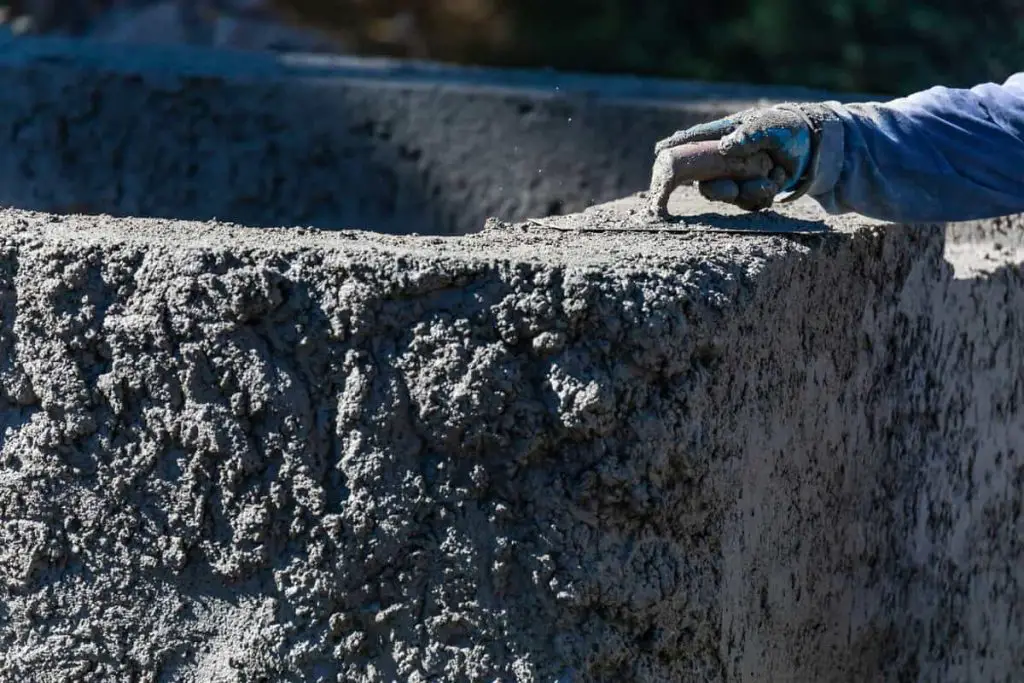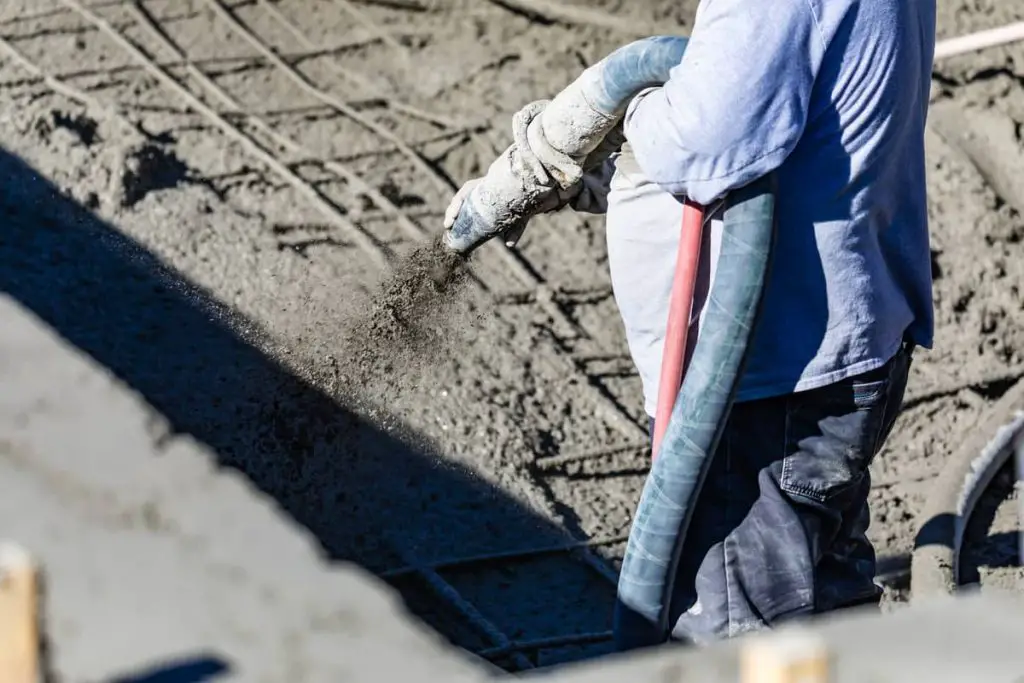With the real estate industry running red-hot, getting all the vital information on a property before closing can be difficult. One tidbit of information that might fall through the cracks is the material used to construct an in-ground swimming pool. So how do you tell if your swimming pool is made of gunite or fiberglass?
Here are six signs that your pool is made of gunite:
- The previous owners tell you it’s gunite.
- The pool construction permits say it’s gunite.
- The pool is on expensive property.
- The pool is 16 ft (5 m) or less wide.
- The pool is made of a hard, rock-like substance.
- The pool is a stable and durable structure.
This article will explain how to tell if your pool is made of gunite.

1. The Previous Owners Tell You It’s Gunite
If you aren’t sure what your swimming pool is made of, the first thing you should do is ask the person or party who sold you the property.
Depending on the property’s age and pool, the previous owner or real estate agency that handled the sale should know how the pool was built or at least be able to contact someone who does. Another possible source of information is the local housing association if there is one.
Most legitimately purchased houses come with hundreds of pages of documentation, including but not limited to blueprints, loan applications and documents, tax records, wiring diagrams, deeds, and relevant permits. As a result, it may take a considerable amount of reading. Still, the records with the house should have everything you need to know about the swimming pool.
Another way to determine how your pool was built is to ask a local pool contractor to inspect it. Again, there’s a fair chance you’ll find the actual contractor who built it. If not, they’ll be able to figure it out for you at a nominal cost.
If those people or parties do not have the necessary information, you can try asking the neighbors. Depending on the property’s age and housing development, some neighbors may have been there when the pool was constructed. If they don’t know the specifics, they may at least give you information with valuable clues.
2. The Pool Construction Permits Say It’s Gunite
In America and every other developed country, bureaucracy is nearly ubiquitous. The government wants to know everything homeowners do to ensure it’s done safely. A swimming pool construction permit is one of the many permits a homeowner may have to acquire.
Depending on your municipality’s ordinances, the pool construction permit might require homeowners to specify the method of construction they intend to use. This information will be listed on the permit held by the local municipality.
Suppose your area does not require that the construction method be specified. In that case, the information you seek can still be found in the local records office. While both gunite and fiberglass pool construction require zoning and HOA permissions, excavation permits, fences and fence permits, and security inspections, gunite pools require additional permits to use the gunite.
In most American and Canadian municipalities, these permits should be digitally stored as paper hardcopies. The electronic copies may be available over the internet.
3. The Pool Is on Expensive Property
Swimming pools, in general, are expensive. According to HomeGuide, a basic fiberglass swimming pool starts at around $28,000 and can cost up to $50,000. Gunite and shotcrete pools are even more expensive, starting at around $80,000.
Suppose you are looking at an upscale property with a swimming pool of unknown construction. In that case, it will probably be gunite or shotcrete pool. You won’t see an above-ground or in-ground fiberglass pool in the backyard of a McMansion.
4. The Pool Is 16 Ft (5 m) or Less Wide
Now we turn to examine the actual pool itself. You can determine a lot about a swimming pool by looking at its size and shape.
There are two types of materials used in modern swimming pools: fiberglass and concrete (gunite and shotcrete). Fiberglass swimming pools are prefabricated in a factory and shipped to the installation site, while concrete pools are built on site.
Transporting a fiberglass swimming pool from the factory to the buyer’s backyard severely limits its size. Specifically, they need to fit on the back of a flatbed truck or trailer. Under federal transport regulations, the maximum width of an object able to be carried on a flatbed truck is 16 ft (4.88 m).
The largest fiberglass swimming pool on the market is the Luxor Deep, produced by San Juan Pools of Lakeland, Florida. It measures a stately 44 ft (13.4 m) long, 16 ft (4.88 m) wide, and 7.1 ft (2.2 m) deep at the deepest end. Legally, this is one of the largest objects that can be transported on American roads without a police escort.
Shape and Law
To give their buyers the largest pool within the width and depth limit, most fiberglass pools are rectangular or close to it. However, since they’re constructed on-site in the buyer’s backyard, gunite pools don’t have this limitation. The only limitation on the size and shape of a gunite or shotcrete pool is the customer’s imagination and checking account balance.
The only legal limitation on the size of a gunite pool is the size of the homeowner’s lot. Due to many child drownings that occurred in the 1990s, most states and municipalities require that all swimming pools be surrounded by sturdy fences at least 4 ft (1.2 m) tall with locking gates. There must also be a gap at least 5 ft (1.5 m) wide between the pool water and the edge of the property.
Gunite and shotcrete swimming pools can be built to almost any shape and depth. According to SwimThings Incorporated, an upscale in-ground swimming pool design house, the most popular shapes are the “Freeform,” “Kidney,” “Rectangle,” and variations thereupon. Large circular pools are also common, especially in older suburban neighborhoods.
You can probably guess what your swimming pool is made of by measuring its width with a tape measure. It’s typically fiberglass if it’s 16 ft (5 m) or less wide.
5. The Pool Is Made of a Hard, Rock-Like Substance
Despite the versatility of gunite/shotcrete pool construction, many homeowners still choose to have them built to proportions that could pass for a fiberglass pool. In this case, you have to take a closer look at the material the pool is made of.
Gunite and its close cousin shotcrete are both types of concrete. The only difference between them is when the water is added to the mixture.
In shotcrete, the concrete is mixed with water and shot out of a tube onto a wood or rebar frame. The dry concrete mix and water arrived at the nozzle separately and mixed in the air before hitting the frame in gunite. The end product of both processes is essentially the same.
Self Diagnostic
Because it’s essentially concrete, gunite is a hard rock-like substance. Once set, the gunite will be covered in a mortar to protect the gunite and make it more attractive. The plaster is also a hard, rock-like substance.
On the other hand, fiberglass is a thermosetting plastic reinforced with glass fibers. It has enormous tensile strength but is not very rigid. Unless it’s backed with a more rigid material like epoxy resin or concrete, a fiberglass pool will have a small give if pushed against it.
Another self-diagnostic test is to tap the pool with a metal tool. If it makes a clang or other metallic noise, the pool is probably gunite or shotcrete. If it makes a thud, it’s probably fiberglass.
The color of a swimming pool used to be a good indicator of its base material. Fiberglass is plastic and can be colored in almost any imaginable shade.
Concrete and mortar used to only come in shades of gray, from off-white to black. But in the last few decades, new pigment additives have been developed that will color both concrete and mortar. Now a gunite pool can be almost any color the customer wants.
Another reason not to trust the color of your pool is vinyl coatings. Some concrete pool owners choose to have their pool lined with a thin colored or patterned vinyl sheet. These coatings are not cheap and only last about a decade.
6. The Pool Is a Stable and Durable Structure
If you’ve exhausted the above tips, there is one final way to determine what your swimming pool is made of- take it apart. Choose an out-of-the-way part of the pool, and cut out a chunk of it with a hole saw. Alternatively, you can hit it with a pickaxe.
Another direct method of examination is to dig underneath it. Fiberglass pools are simply placed in a hole in the ground, while gunite and shotcrete pools are much more complicated structures.

Key Takeaways
Knowing what type of pool you have on your property is essential for many reasons. Not only is it important to know about the upkeep of the pool itself, but it’s also vital information to consider if you decide to renovate.
The best way to tell if your pool is gunite is to ask the previous owners and check the construction permits. However, considering signs such as the type of property, shape, and size of the pool, and materials used can help determine if your pool is gunite.
Sources
- American Legal Publishing: 151.085 Swimming Pools; Generally
- HomeGuide: How Much Does An Inground Pool Cost
- Youtube: Submitting for Permit & HOA Approval – – Pool Talk with Trish – Austin, New Braunfels, San Antonio
- San Juan Pools: The Luxor Deep
- SwimmingPool.com: What are the Steps to Building a Pool?
- SwinThings Incorporated: Shapes & Sizes Gunite Pools
- Wikipedia: Flatbed Truck
- Wikipedia: McMansion
- Wikipedia: Shotcrete
